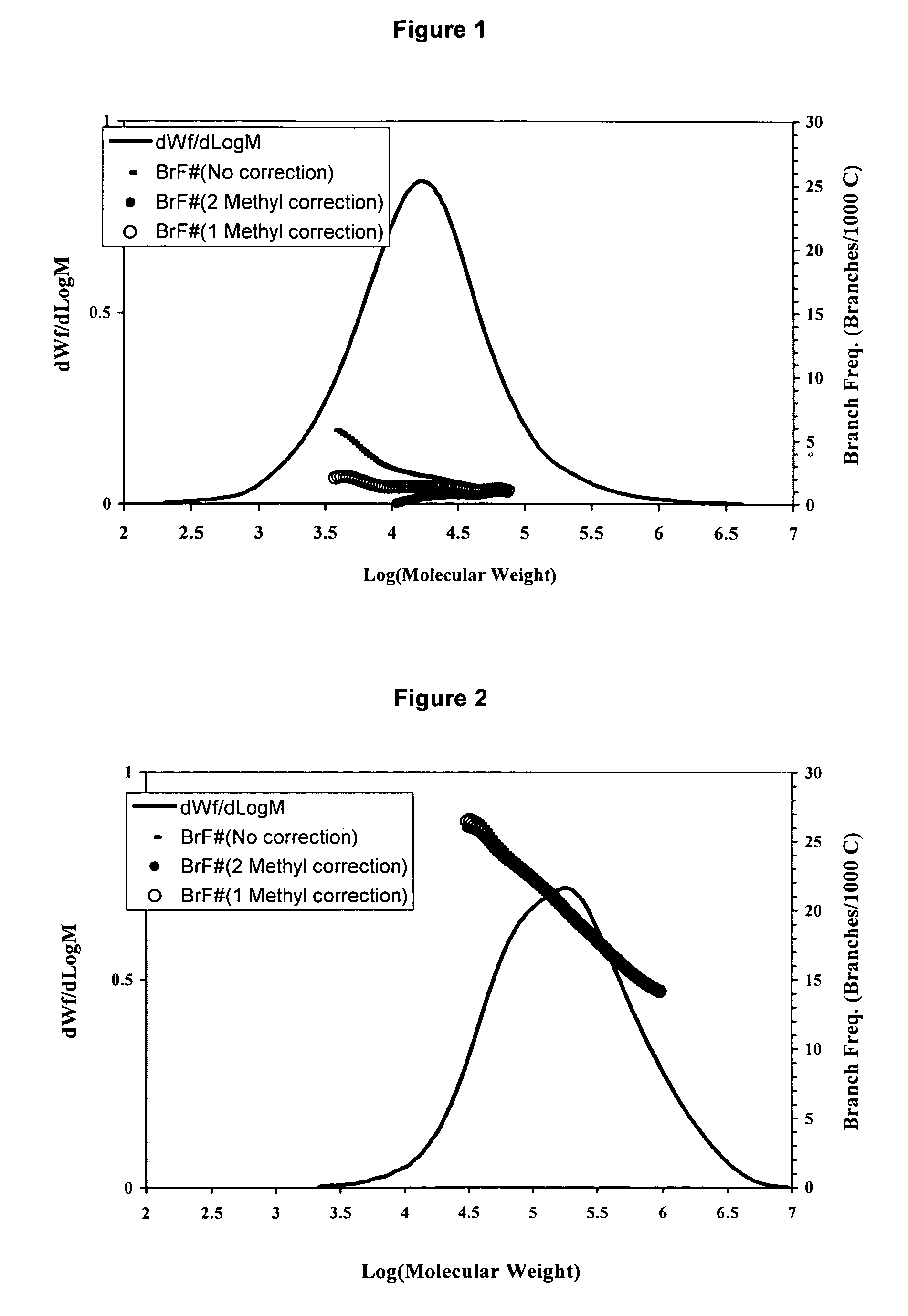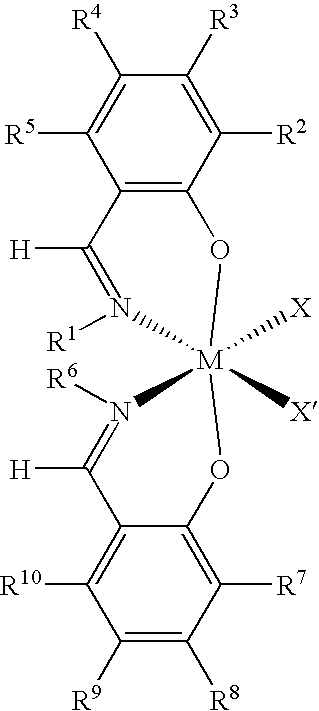Polymer blends
a polymer and resin technology, applied in the field of polymer blends, can solve the problem that the patent does not teach the blending of resins with resins
- Summary
- Abstract
- Description
- Claims
- Application Information
AI Technical Summary
Problems solved by technology
Method used
Image
Examples
example 1
Preparation of Catalyst for the First Polymer Component
[0169]EtMgBr (100 mL, 3M solution in diethyl ether) was added dropwise to a solution of 4-methoxy-2-tert-butyl-phenol (290 mmol) in tetrahydrofuran (THF) (350 mL) at ambient temperature to give an amber solution. After 2 hours of stirring, toluene (250 mL) was added, and the ether and THF were removed by distillation. Triethylamine (60.6 mL) and paraformaldehyde (21.8 g) were then added as a white slurry in toluene. The reaction was stirred overnight, followed by heating for 2 hours at 95° C. to give a cloudy orange solution. The resulting reaction mixture was poured into 1M HCl while cooling to 0° C. The organic layer was separated and the aqueous phase extracted with diethyl ether. The combined organic phases were dried over Na2SO4, and then evaporated to give an oily orange material. The oil was dissolved in ethanol (250 mL) and to the clear orange solution was added cyclohexylamine (32.9 mL). The reaction was stirred for 48 ...
example 2
Preparation of Catalyst for the Second Polymer Component
[0172]Sodium cyclopentadiene (615 mmol) was dissolved in tetrahydrofuran and a solution of perfluorobenzene (309 mmol) was added as a 1:1 solution with THF over a 20 minute period. The resulting mixture was for 3 hours at 60° C., allowed to cool, then added by cannula transfer to neat chlorotrimethylsilane (60 mL) at 0° C. over 15 minutes. The reaction was allowed to warm to ambient temperature for 30 minutes, followed by slow concentration over a 3 hour period to remove excess chlorotrimethylsilane and solvents. The resulting wet solid was slurried in heptane and filtered. Concentration of the heptane filtrate gave crude (TMS)(C6F5)C5H4 as a brown oil which was used without further purification. (TMS)(C6F5)C5H4 (78 mmol) was dissolved in THF and cooled to 0° C. The solution was treated with n-BuLi (78 mmol), which was added dropwise. After stirring for 15 minutes at 0° C., the reaction was allowed to warm to ambient temperatur...
example 3
Preparation of the Blend
[0175]A blend of the resins produced in Examples 1 and 2 was prepared by solution method although other techniques such as extrusion could be used. An equal amount of the resins produced in Examples 1 and 2 were dissolved together in 1,2,4-trichlorobenzene at 150° C. for 4 to 5 hours. The solution was then injected into a GPC or GPC-FTIR equipment under conditions described in the previous session. As shown in Table 1 and FIG. 3, a bimodal resin was produced with very broad molecular weight distribution and reserve comonomer placement suitable for applications in films, pipes, geomembrane and blow molding.
[0176]
TABLE 1Molecular Weight Characteristics of ResinsMnMwMzMw / MnExample 18,80031,100107,4003.5Example 2108,300353,400944,5003.3Example 317,100241,300923,50014.2
PUM
| Property | Measurement | Unit |
|---|---|---|
| particle size | aaaaa | aaaaa |
| weight % | aaaaa | aaaaa |
| weight % | aaaaa | aaaaa |
Abstract
Description
Claims
Application Information
 Login to View More
Login to View More - R&D
- Intellectual Property
- Life Sciences
- Materials
- Tech Scout
- Unparalleled Data Quality
- Higher Quality Content
- 60% Fewer Hallucinations
Browse by: Latest US Patents, China's latest patents, Technical Efficacy Thesaurus, Application Domain, Technology Topic, Popular Technical Reports.
© 2025 PatSnap. All rights reserved.Legal|Privacy policy|Modern Slavery Act Transparency Statement|Sitemap|About US| Contact US: help@patsnap.com



